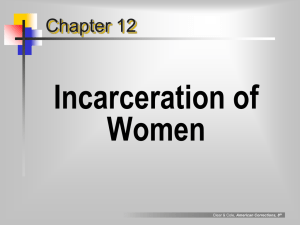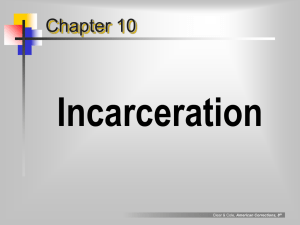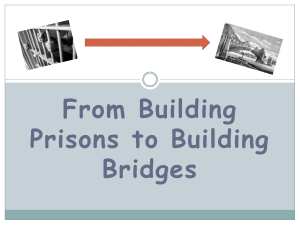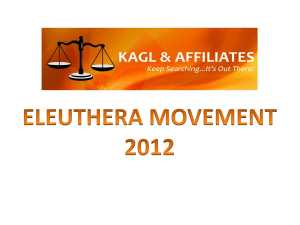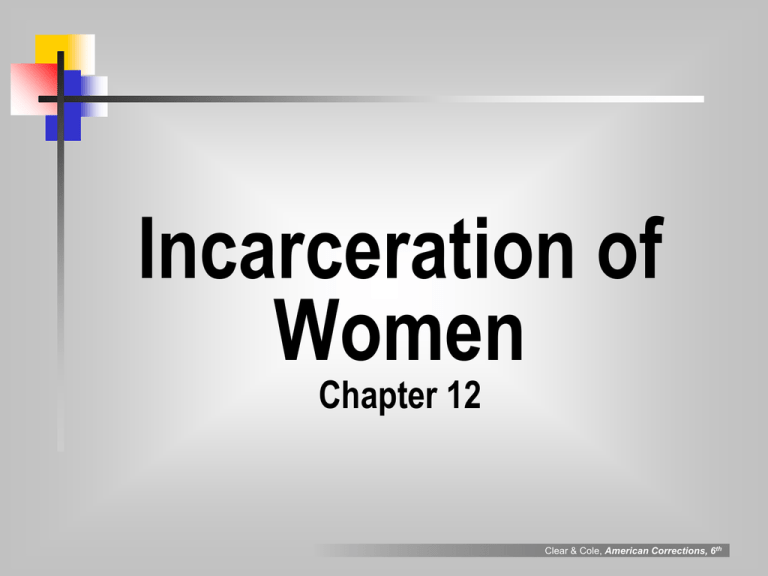
Incarceration of
Women
Chapter 12
Clear & Cole, American Corrections, 6th
Acknowledging Gender:
Key Differences
Sex & gender differences
Health issues
Violence against women & children
Interrelationship between substance
abuse, mental health & trauma
Socioeconomic status: employment
& education
Clear & Cole, American Corrections, 6th
Women Tend to be
the “Forgotten Offenders”
women commit fewer crimes than men
female criminality tends to be less serious
than male criminality
historically, women have tended more
often than men to be ignored by the justice
system
women constitute a small proportion of the
U.S. prison population (7%) but the number
of women prisoners is increasing faster
than that of men prisoners.
Clear & Cole, American Corrections, 6th
Women’s Prisons
women’s
prisons are located farther from
friends & family, inhibiting visits,
especially for the poor
women’s prisons lack diverse educational,
vocational, and other programs available
in men’s prisons
women’s prisons lack specialization in
treatment
Clear & Cole, American Corrections, 6th
Female Prison Reform in 1800s
separation of women from men
provision of differential care for women
management of women’s prisons by female staff
Elizabeth Fry – 19th century English Quaker who
was a champion of women’s prison reform
Clear & Cole, American Corrections, 6th
Characteristics of Women in
the Criminal Justice System
More than one million women are currently
under criminal justice supervision in the U.S.
Women comprise 17% of the total number of
offenders under CJ supervision
The number of women in state and federal
prisons increased over nine-fold, from
12,300 in 1980 to 114,979 in 2009.
Clear & Cole, American Corrections, 6th
Women in the C.J. System
The number of women in prison has increased at nearly
the double the rate of men since 1985, 404% vs. 209%.
Women have not become more violent as a group.
Women are less likely than men to incarcerated for a
violent offense (35% vs. 53%)
Women are more likely to have been convicted of crimes
involving property (30%) or drugs (29%) .
Drug offenses represent the largest source of population
growth for women, as opposed to violent offenses for
men.
Clear & Cole, American Corrections, 6th
Who are the Women?
• Disproportionately women of color
• In their early to mid-thirties
• Most likely to have been convicted of a
property or drug offense
• Fragmented family histories with other
family members in the CJ system
• Survivors of physical and/or sexual abuse
Clear & Cole, American Corrections, 6th
•
Significant substance abuse problems
•
Multiple physical & mental health
problems
•
Unmarried mothers of minor children
•
High school degree/GED
•
Limited vocational training
•
Sporadic work histories
Clear & Cole, American Corrections, 6th
Women in California Prisons
The female prison population in California has grown
more rapidly than the male prison population.
Between 1983 and 2009, the number of women
incarcerated in California increased five-fold, from about
2,000 to 11,000. There are currently 9,500 women in CA
prisons.
Women make up about 7% of the prison population.
There are 12,000 women on parole.
Women make up about 12% of the parole population.
Clear & Cole, American Corrections, 6th
Offense Profiles of
CA Female Inmates
In 2007, over two-thirds of female inmates in California
prisons were serving sentences for property (33%),
drug (28%) or other offenses (7%).
In 2007, 30% of female inmates were serving sentences
for crimes against persons as compared to 52% of male
inmates.
Clear & Cole, American Corrections, 6th
Race & Ethnicity
African
American women comprise only 13%
of all women in the U.S., yet they make-up
nearly half of the women in State and Federal
prisons.
In
2005, Black women were more than three
times as likely as white women to be
incarcerated in prison or jail.
Similarly,
in California, African American
women and Latinas are overrepresented in
our prison system.
Clear & Cole, American Corrections, 6th
The Context of Women’s Lives
Pathways Perspective
Relational – Cultural Theory
Trauma Theory
Addiction Theory
Clear & Cole, American Corrections, 6th
Substance Abuse
Approximately 80% in state prisons have
substance abuse problems
About half had been using alcohol, drugs, or both
at the time of their offense
Nearly 1 in 3 women in state prisons report
committing the offense to support a drug habit
Women offenders in state prisons report higher
drug usage than their male counterparts
Clear & Cole, American Corrections, 6th
The Drug-Crime Connection for Women
Onset
in women faster & deeper
Onset
of drugs first, crime usually follows
closely
Dual
diagnosis relationship
Role
of self-medication & trauma
Clear & Cole, American Corrections, 6th
Violence Against Women
and Children
•
Witnessing domestic violence as a child
may cause increased vulnerability to victimization in
adulthood
•
Women in the CJ system have extensive histories of
physical & sexual abuse and are 3 times more likely than
men to have a history of abuse
•
One-third of women in state prison & one-quarter of those
in jails report being raped at some time in their lives
•
Women’s substance abuse is highly correlated with
physical & sexual abuse
Clear & Cole, American Corrections, 6th
Mental Health
Women in the criminal justice system have a higher
incidence of mental disorders than women in general
Female inmates in state prisons had higher rates of mental
health problems than male inmates (73% of females vs.
55% of males)
Women offenders have histories of abuse associated with
psychological trauma
Approximately 75% with serious mental illness also have
co-occurring substance abuse disorders
Women with mental illness & co-occurring disorders
experience difficulties in prison & jail settings
Clear & Cole, American Corrections, 6th
“Pseudo-families”
a distinguishing hallmark of the
“subculture” in many women’s prisons
(as compared with men’s)
women
often cope with the stresses of
incarceration by bonding together in
extended “families” of convenience.
different women play the roles of various
members of the family, including father,
mother, siblings, grandchildren, even
cousins
Clear & Cole, American Corrections, 6th
Key Issues in the Incarceration of
Women
educational & vocational training
female programs tend to reflect
stereotypical “female” occupations
medical services
women have more serious health
problems– In 2004, one of every 42
(2.4%) women in prison was diagnosed
as HIV positive compared to one of
every 59 (1.7%) men
mothers & their children
majority of women are mothers
Clear & Cole, American Corrections, 6th
Children
•
Approximately 70% of
women under
correctional supervision
have at least 1 child
under 18
•
Two-thirds of
incarcerated women
have children under 18
•
An estimated 1.3 million
minor children have a
mother under
correctional supervision
•
More than a quarter of a
million children have
mothers in jail or prison
Clear & Cole, American Corrections, 6th
Why Punish The Children?
Incarceration
takes a significant toll on
children who often witness their mother’s
arrest and are at risk of being separated from
their siblings, either by being placed with
relatives or in foster care.
It
is estimated that children of offenders are
five times more likely than their peers to end
up in prison themselves.
One
in ten will have been incarcerated before
reaching adulthood.
Clear & Cole, American Corrections, 6th
Major Differences Between Male and
Female Prisoners
Women prisoners receive fewer visits than their
male counterparts. Many states have only one
women’s prison which is located far away from
children and families
Women are less violent
Women form close relationships and pseudo
families while men join gangs
Women were usually the primary caretaker of
children prior to incarceration and plan to reunite
with their children upon their release from prison
Clear & Cole, American Corrections, 6th
National Institute of Corrections GenderResponsive Strategies (Bloom, Owen, &
Covington (2003) Guiding Principles
• Acknowledge that gender makes a difference.
• Create an environment based on safety, respect,
and dignity.
• Develop policies, practices, and programs that
are relational and promote healthy connections
to children, family, significant others, and the
community.
Clear & Cole, American Corrections, 6th
Guiding Principles Continued
• Address substance abuse, trauma, and
mental health issues through
comprehensive, integrated, and culturally
relevant services.
• Provide women with opportunities to
improve their socio-economic conditions.
• Establish a system of comprehensive and
collaborative community services.
Clear & Cole, American Corrections, 6th
Barriers Facing Women Returning to
their Communities
Welfare Benefits
Housing
Education and Employment
Reunification with Children
Clear & Cole, American Corrections, 6th
Legal Barriers
Personal
Responsibility & Work Opportunity Act
of 1996
Temporary Assistance for Needy Families
(TANF)
Higher Education Act of 1998
Public Housing - Section 8
Adoption and Safe Families Act of 1997
Clear & Cole, American Corrections, 6th
Recommendations for Improving
Reentry Services for Women
Alternatives to incarceration should be the sanction of
first choice.
For women who are incarcerated, planning for reentry
should begin at the start of the prison sentence.
Women should be released from prison with the tools
and support they need to succeed in the community.
Communities should be provided with the necessary
resources to assist women and their families.
Public policies should promote family and community
well-being.
Clear & Cole, American Corrections, 6th
The California Approach
Instituting, for the majority of female offenders who
will be released to the community, a reentry plan at
reception.
Promoting a continuity-of-care model which provides
support services from incarceration through
transition to the community.
Designing wraparound services for each individual
woman including substance abuse, mental health,
trauma, family reunification, housing, financial
assistance, educational, employment, childcare,
transportation, and advocacy.
Clear & Cole, American Corrections, 6th

